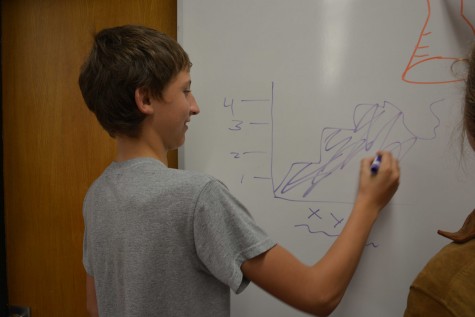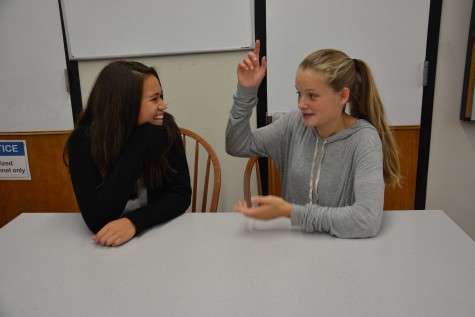What’s your learning style?
More Feature
Junior Sarah Murad poses as if doing a lab, showing one engaging activity which benefits kinesthetic learners. Movement is an important element in their learning processes.
In every class, information is passed to students through textbook readings, demonstrations, videos and games. These methods target different learning types to allow for understanding.
According to renowned education professor Alan Pritchart’s book, Ways of Learning: Learning Theories and Learning Styles in the Classroom, people began digging deeper into the idea that individuals possess different learning styles around the 1970s.
Beginning with the work of Dr. Russel French on different learning styles, the idea that different people learn in different ways continued to develop. Later on, teacher Neil Fleming developed a categorizing system called VARK (visual, auditory, reading/writing, and kinesthetic.)
The major cognitive learning styles are commonly used today to define the facets of learning strengths: visual, auditory, and kinesthetic. It’s possible to identify with a single or multiple learning types. No matter which or how many someone falls under, here are a few methods for studying effectively.
The Kinesthetic Learner: those who identify as kinesthetic learners learn through interaction and motion. This ranges from discussing a question with a partner to demonstrating an idea in large group activities.
[For visual learners] to stay on top of a busy schedule, students could try using alarms on a computer or smart phones flexibly.
Opting for physical elements and activities, Kinesthetic learners makes action out of ideas. Any student who considers themselves kinesthetic has a few options. Published author and Editor in Chief of Unclutter.com, Erin Doland places great emphasis on having area for movement. Whether stretching, tapping one’s foot, or using one’s hands to explain a concept out loud, space is needed.
Education consultant Donna Goldberg’s writes in her book The Organized Student, that “They [kinesthetic learners] learn best when they… act out concepts and construct models.”
Interactivity is also important in a student’s study area, so using a dry erase board to write ideas down or keeping some paper handy may be important. An article by the VARK website states that “If it can be grasped, held, tasted, or felt it will probably be included.”
Kinesthetic learners appreciate five-minute walk and talks, writing ideas on the board in class, and labs.
The Visual Learner

As a visual learner, one values aesthetics and organization. Studying is significantly more enjoyable when it’s been made so. There are lots of different ideas and tips on how to enhance homework, but here are a few of the most successful. Primarily, a visual learner should be able to see all important things.
Everything must be in one place–for example, one calendar is better than Veracross, a school planner, and an iPhone calendar. Being able to see it all allows one to literally visualize any events and assignments. Another suggestion is color-coding, or having a basic system for notes and homework.
Furthermore, one may apply a color system to folders, notebooks and binders–if each subjects is assigned a color, finding any related material can be done with ease.
A more decorative element would be a bulletin board, hung up in plain sight. One may put up/tack reminders, inspiration, and important concepts to keep in mind. Finally, sticky notes provide a very efficient system.
After jotting down a phrase or sketching a quick diagram on these handy papers, one can place
the piece of paper anywhere and everywhere.
The Auditory Learner: AUDITORY LEARNERS BENEFIT from hearing information in the form of lectures or discussions. Hearing an idea, and even listening to it over again, is the most efficient way for auditory style students to grasp it.

The most suggested tip for auditory learners is to have background music playing as they work, with or without lyrics. While music may not work well for everyone who fits into this learning type, some other background noises are a possibility. In either case, having ear buds, headphones or a speaker may come in handy.
Speaking is another option Talking out loud allows the individual to hear the idea, as would explaining it to someone else. Asking a friend to explain their understanding of a concept is a great way to hear a description. When in doubt, a student may drop by the teacher’s classroom and ask for a brief explanation for clarification purposes.
To stay on top of a busy schedule, students could try using alarms on a computer or smart phones flexibly. Another option, which is also quick and easy with a smart phone, is voice recording. When studying at home, Carolyn Purnell, a contributor to Apartment Therapy, proposes that simply recording notes and listening to them will help one to understand a concept. This method would serve as the auditory version of sticky notes, and is easy to do using a smartphone.
Senior Iya Abdulkarim is a driven writer, photographer, designer, and The Rubicon's Editor-in-Chief. Over the past four years, an interest in storytelling...